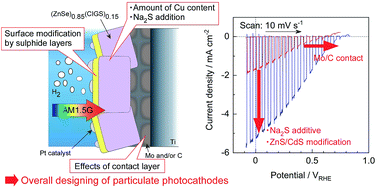A particulate solid solution, (ZnSe)0.85(CuIn0.7Ga0.3Se2)0.15, was synthesized by the flux method using various amounts of a Cu precursor (to make Cu-deficient, stoichiometric, or Cu-excess specimens) and/or a Na2S additive, to assess the effects of synthesis conditions on photoelectrochemical (PEC) properties. A stoichiometric (ZnSe)0.85(CuIn0.7Ga0.3Se2)0.15 photocathode prepared with Na2S produced a cathodic photocurrent in a neutral aqueous electrolyte approximately 2.3 times greater than that obtained from a sample made without Na2S. Elemental analyses by inductively coupled plasma mass spectrometry and X-ray photoelectron spectroscopy demonstrated that the presence of Na2S facilitated the incorporation of Li from the flux into the solid solution, in addition to the insertion of O atoms at Se vacancies, during the synthesis. Consequently, a (ZnSe)0.85(CuIn0.7Ga0.3Se2)0.15 photocathode with appropriate surface modification and back contact demonstrated an onset potential for cathodic photocurrent as high as 0.77 VRHE, a −5.2 mA cm−2 of photocurrent at 0 VRHE and a half-cell solar-to-hydrogen conversion efficiency of 1.1% at 0.37 VRHE. The present study provides new insights into techniques for the preparation of particulate Cu-chalcogenide photocathodes for efficient hydrogen evolution.
